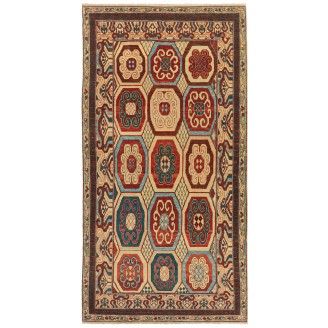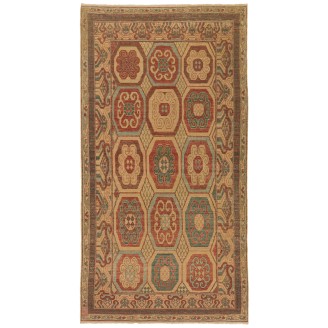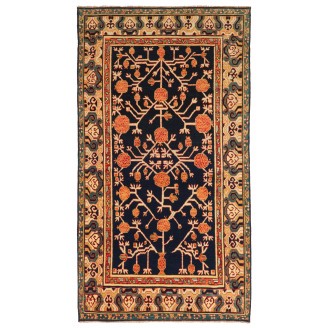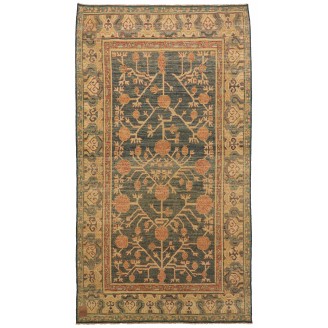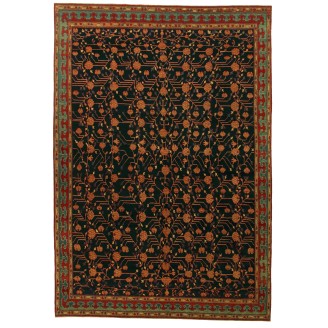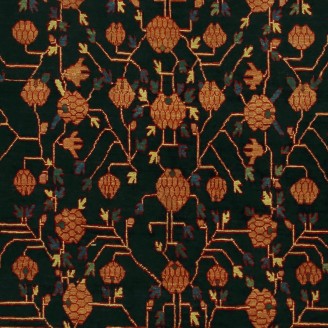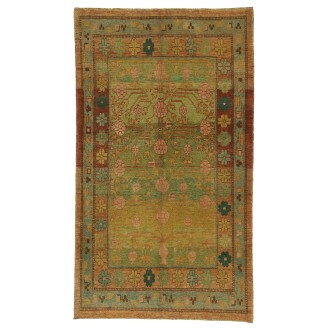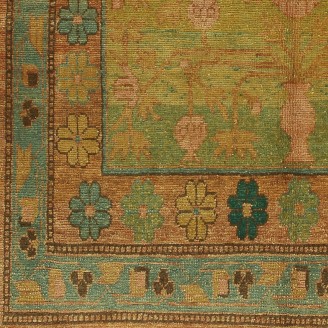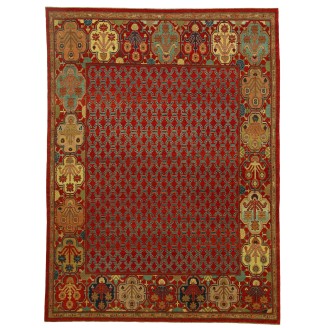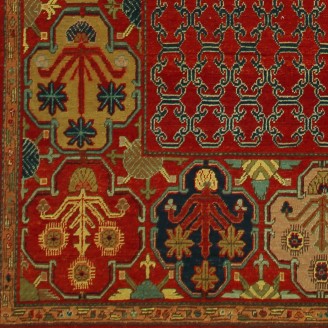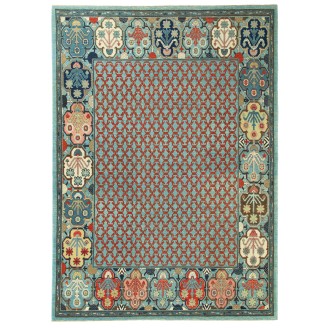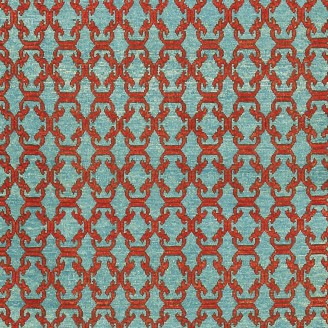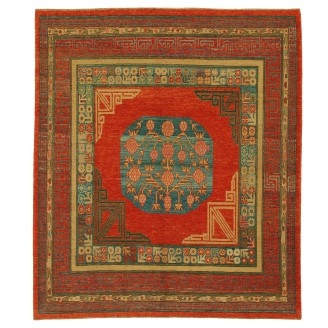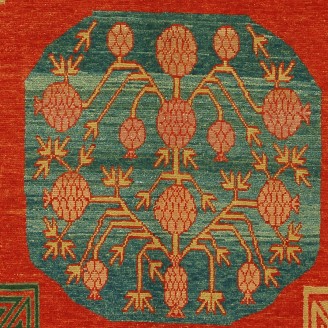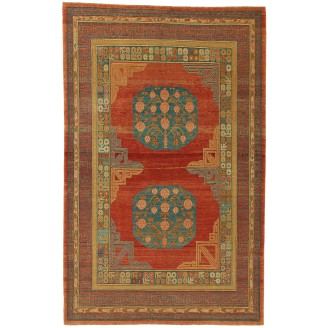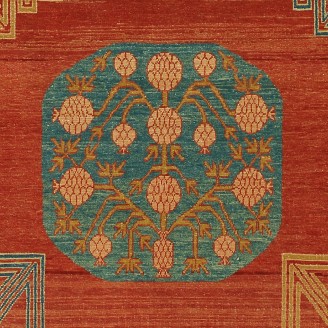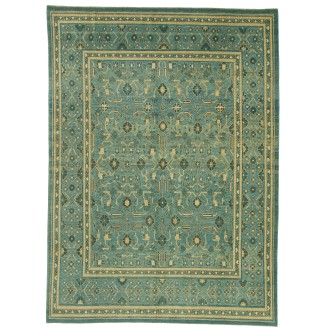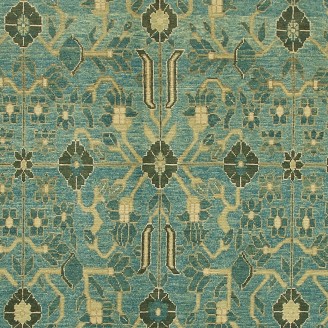‘Central Asia’ is the name given to that vast territory, extending from the Caspian Sea to Chinese Turkestan, the Aral Sea, and the northern part of Afghanistan, across which for centuries the old trader caravans meandered back and forth along the Silk Route. Conquered by Russia in the 19th century, this much-contested region was renamed ‘Russian Turkestan’ and divided into five republics: Uzbekistan, Kirgizstan, Kazakhstan, Turkmenistan, and Tajikistan. In these lands, with their arid steppes, deserts, and mountainous massifs, live nomadic and semi-nomadic tribal peoples, loyal to their ancestral traditions, who weave on horizontal looms and produce relatively simple rugs designed to cover the floors of their yurts.
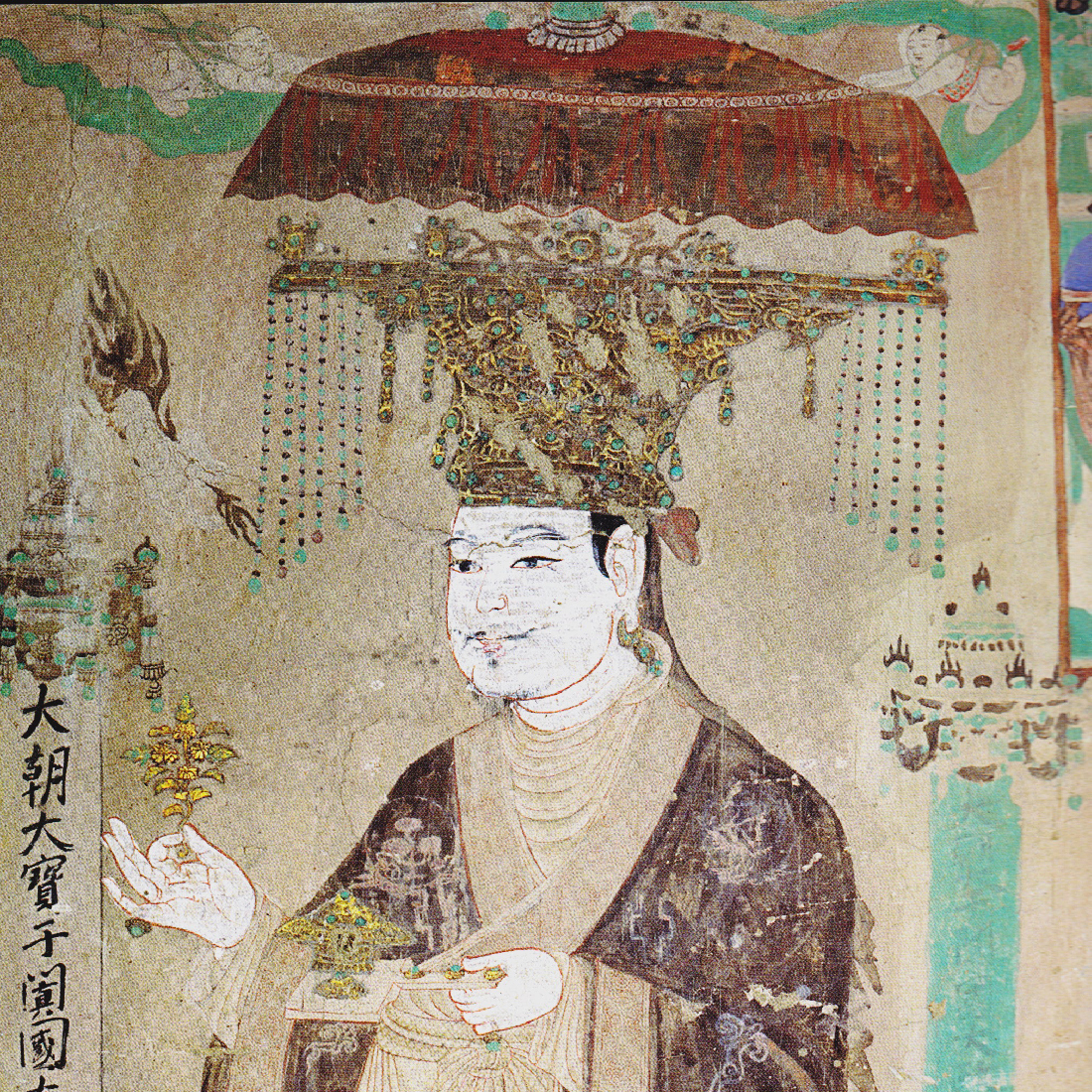 Portrait of Viśa' Saṃbhava, a 10th-century king of Khotan, Mogao Caves, Dunhuang, Gansu province
Portrait of Viśa' Saṃbhava, a 10th-century king of Khotan, Mogao Caves, Dunhuang, Gansu provinceKhotan (also known as Gosthana, Gaustana, Godana, Godaniya, Hotan, Hetian, and Hotien) is a major oasis town in southwestern Xinjiang, an autonomous region in Western China. The region passed under many powers during the next two thousand years. The Chinese control, from the second century B.C. to the fourth century A.D. and from the seventh to tenth centuries, was primarily a matter of maintaining garrisons to secure the silk routes to the West, and no attempts at colonization were made; this was true even after the Manchus reconquered the western province in 1757. In the interim, under various Turkish and Mongol overlords, the cultural orientation was westward, particularly after the Turkish ninth-century migrations through the basin, which imposed a Turkic language and the Islamic religion. Nevertheless, the resident population of the oases remained almost unchanged, and even today, they show Indo-European facial characteristics and coloring.
Our first direct evidence of carpet making in Khotan is contained in the finds of Sir Aurel Stein, who traveled widely in the area from the 1920s until he died in 1953. In several burial sites around Niya, east of Khotan, and near Lake Lop Nor, he found knotted carpet fragments dated anywhere from the third to the sixth century A.D., which places them as the second oldest finds of knotted pile rugs. There is still some question as to just where these carpets were produced. Still, the writings of Chinese travelers suggest that pile carpets were made in Khotan and Kashgar during the seventh century. However, Marco Polo, who traversed the same territory, fails to mention such an industry. Information is sparse as to whether carpets were made during Western orientation from the tenth through mid-eighteenth centuries, but production possibly continued. With the return of Chinese ascendancy, we have many descriptions of carpets from travelers.
The designs are generally of three varieties: 1) One or more medallions, 2) Variations of the vase and pomegranate motif, or 3) Gul designs reminiscent of western Turkoman patterns, but usually surrounded by a geometrical coffering. There are occasional rugs with overall patterns based on the Herati or other classic Persian designs, but these can usually be distinguished from their Western counterparts. The most common design is the medallion, with one, two, or three nearly circular medallions arranged longitudinally on a rectangular field. If there are more medallions, the arrangements differ; with five, we find one in each corner and one in the center, and with an even number, they may be arranged side by side. The three-medallion carpet is the most frequent. Whatever the field design, the same limited range of border designs is found, with one main border and 3 to 9 smaller stripes. These are often derived from the swastika in various connected forms. The clouded motif is also common, along with simple Greek or Chinese key motifs.
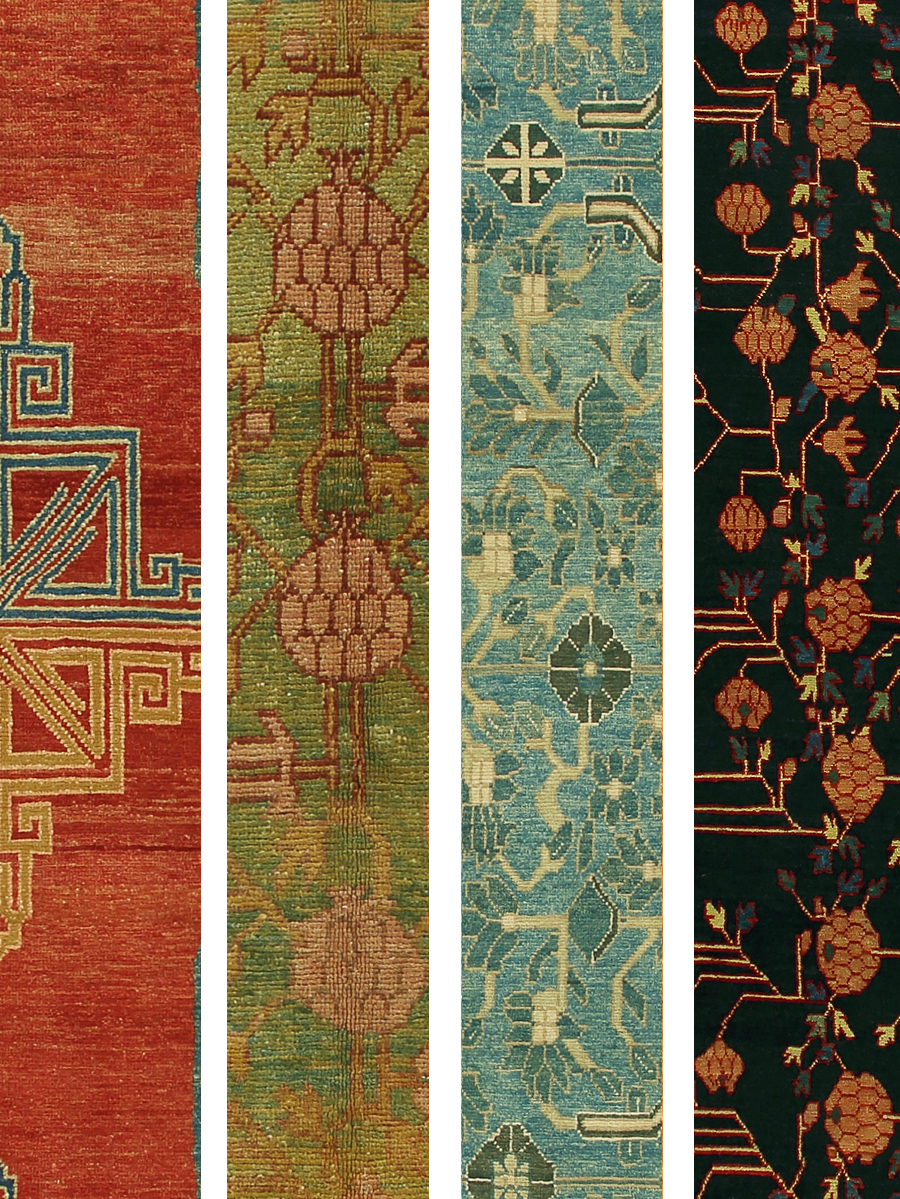 Khotan Patterns
Khotan Patterns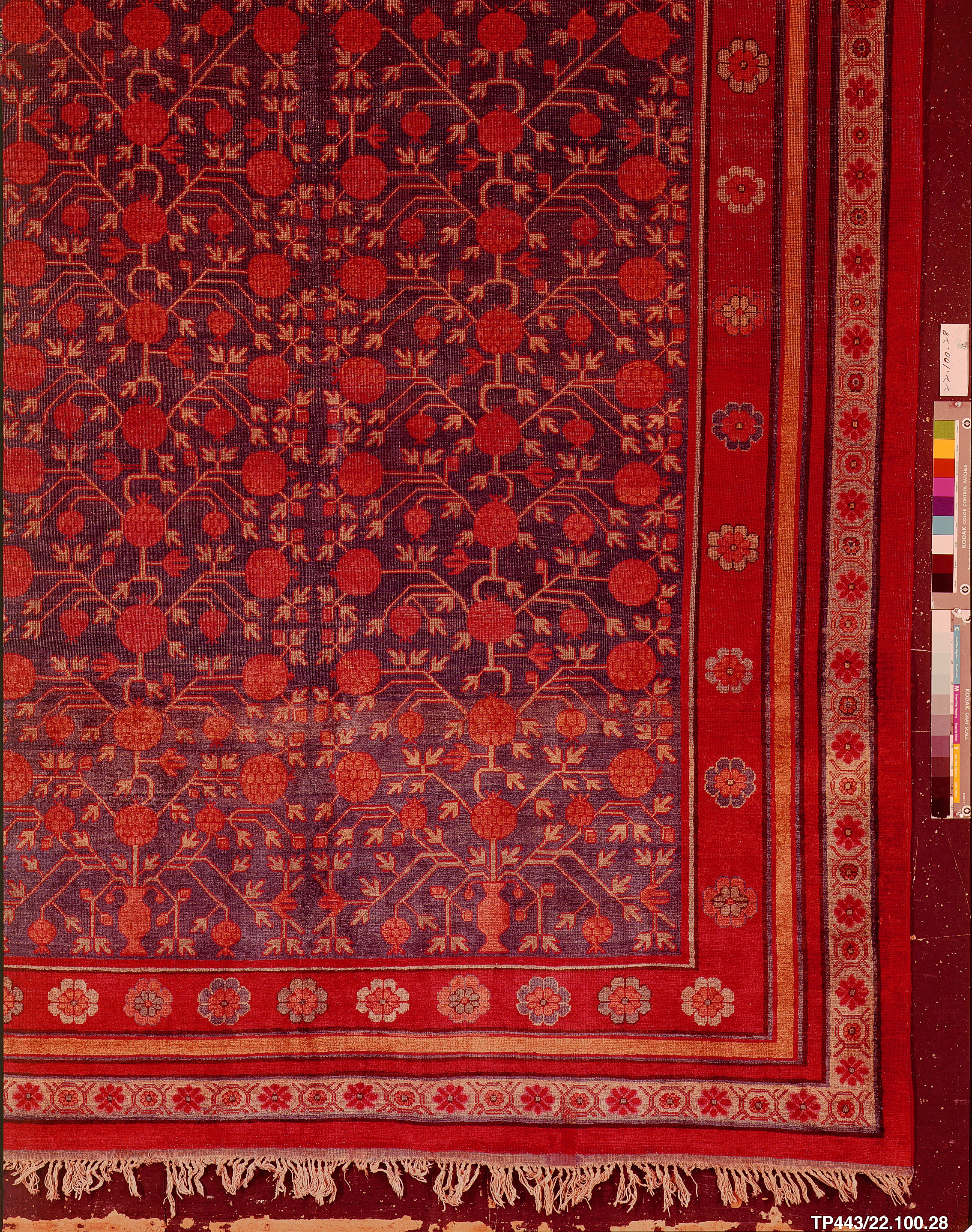 Carpet attributed to Khotan, Kashgar or Yarkand, late 18th–early 19th century, The Metropolitan Museum of Art, New York
Carpet attributed to Khotan, Kashgar or Yarkand, late 18th–early 19th century, The Metropolitan Museum of Art, New YorkCarpets woven in the former Silk Road settlements of Kashgar, Yarkand, and Khotan, situated at the western end of the Taklamakan Desert, display a mixture of patterns and styles. Chinese influence can be seen in the palette–emphasizing deep red, blue, and yellow–and in some patterns, particularly those of the borders.
Recent carpets from Eastern Turkestan are notable for their soft wool, which is grown mostly by Kirghiz tribe members inhabiting the foothills of the Kun Lun range. The dyes are similar to those found in other oriental carpets before the influx of analyses after 1870. Cochineal and indigo were long imported from India, and there was a particularly bright, rich red in many of the old carpets (called Tibetan red), which allegedly came from the saffron flower. Dark colors, browns and black, were usually natural shades of wool and thus did not show increased wear as in many Persian carpets. The palette was somewhat limited, primarily using only light and dark blue, bright and wine red, light and dark yellow, and various natural shades. With the advent of synthetic dyes, we have a wider range, particularly with magenta and orange.
In size, Eastern Turkestan rugs are more uniform than those from most areas; the classic examples usually measure twice as long as they are wide; the commonest dimensions are about 3.6 x 7 feet and 7 x 14 feet. Those specimens were considered the earliest are more likely to be nearly square, and by the early twentieth century, another group of rugs in dimensions more suitable to Western tastes; among these, one may encounter some 9 x 12-foot carpets. Structurally, these rugs show little variability, and this adds to the problem of specifically assigning them to any oasis center or another. Virtually without exception, they have thick cotton wefts of four to six strands plied together, and they appear to be essentially all Persian knotted. (The rare pieces with Turkish knotting usually have additional questionable features that make their origin doubtful.) In some pieces of apparently early manufacture, alternate warps are significantly depressed, and the knotting is relatively fine. Recent rugs show wefts more or less on the same level, with a knot count usually between 30 and 80 to the square inch. Usually, one will find three wefts of dark wool between each row of knots, although there may occasionally be four or more. One group of rugs, however, shows undyed or blue cotton wefts, often only two strands, and another group has two or three strands of light wool. Some scholars have attempted to localize these techniques to Yarkand and Kashgar, respectively, but the evidence is meager.
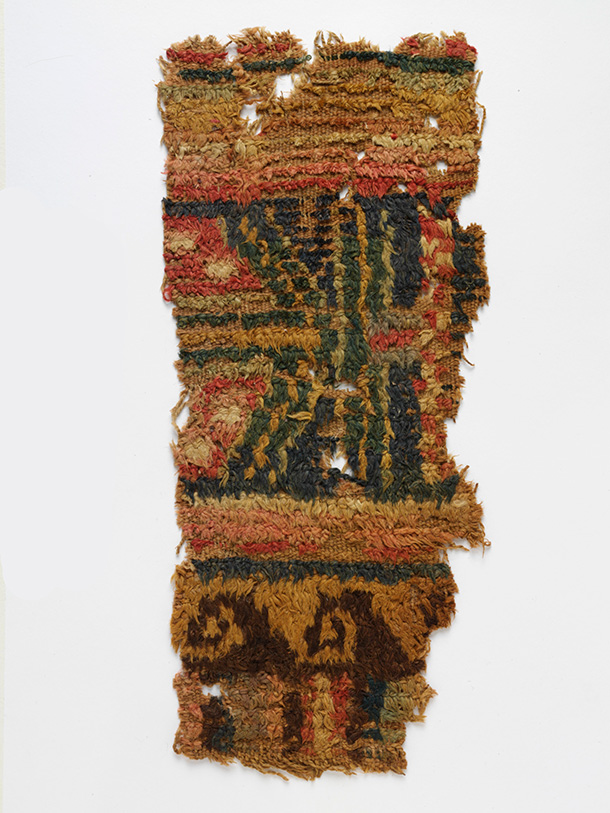 Carpet fragment, unknown maker, excavated from Loulan, China, 150–60 C.E., knotted wool on wool warp and weft. Museum no. LOAN.STEIN.647. © Victoria and Albert Museum, London
Carpet fragment, unknown maker, excavated from Loulan, China, 150–60 C.E., knotted wool on wool warp and weft. Museum no. LOAN.STEIN.647. © Victoria and Albert Museum, London
